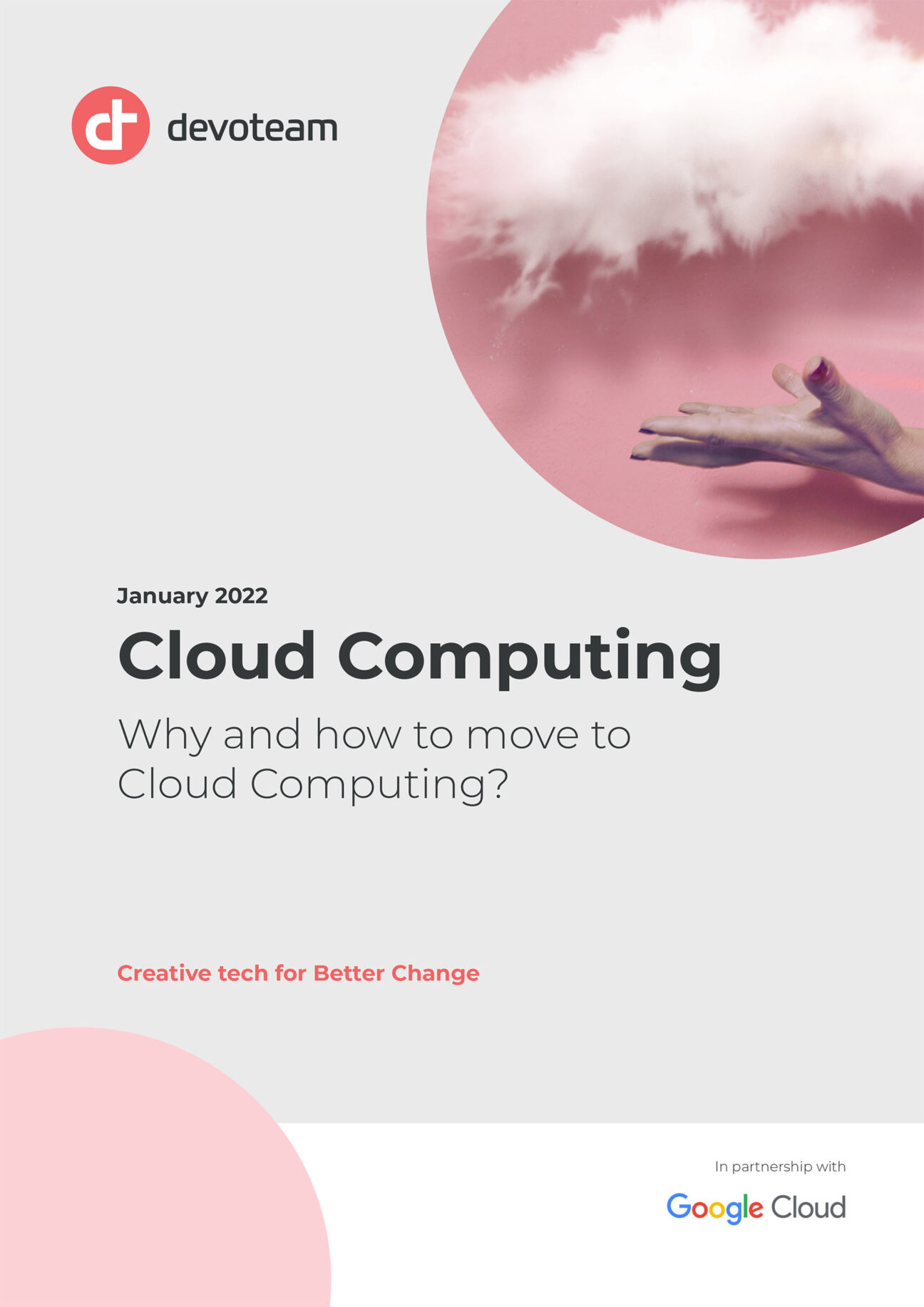We believe that modernising your business through cloud computing is the way to go to achieve the goals mentioned above. However, it should be noted that “modernising” does not necessarily mean “revolutionising”.
The move is in fact a step-by-step process that can be adapted according to the company’s level of maturity. There are three main strategies, each presenting several approaches or scenarios, for making a switch to the Cloud: migrate as is, re-format to switch to managed services, and redesign or develop new applications from native Cloud services. For over 20 years, Google’s mission has been to make information accessible and useful to everyone. Over the years, Google has distinguished itself through its ability to innovate, first for its own internal needs and then by making its solutions available to the general public and businesses. It is in this spirit that the Google Cloud Platform saw the light of day in 2011.
Of all the considerations that can be made about IT, one persists: the appeal of talent. Application modernisation is also about empowering employees to spend time on more interesting and value-added tasks, and thus avoid tedious off-duty operations.
Migrating your IT as is
It is simply a question of using the Cloud to optimise the existing system from a technological or even mechanical point of view, either by using the hardware resources of the Cloud to boost the system still in place on site, or by migrating it completely. The choice will depend on the company’s environment, the existing system and its overall technological roadmap.
Option 1: Deploy your VMWare environment on Google Cloud Platform
This is generally referred to as Lift & Optimize. For VMWare users, GCP allows you to get started right away by migrating your VMware environment in a few clicks, without refactoring your applications. The principle is extremely simple: you run your applications on a native VMware Cloud Foundation software stack, entirely managed by Google Cloud. This frees you from the time-consuming task of managing your VMWare infrastructure, while continuing to use your existing tools and processes.
Why use Google Cloud VMware Engine (GCVE)?
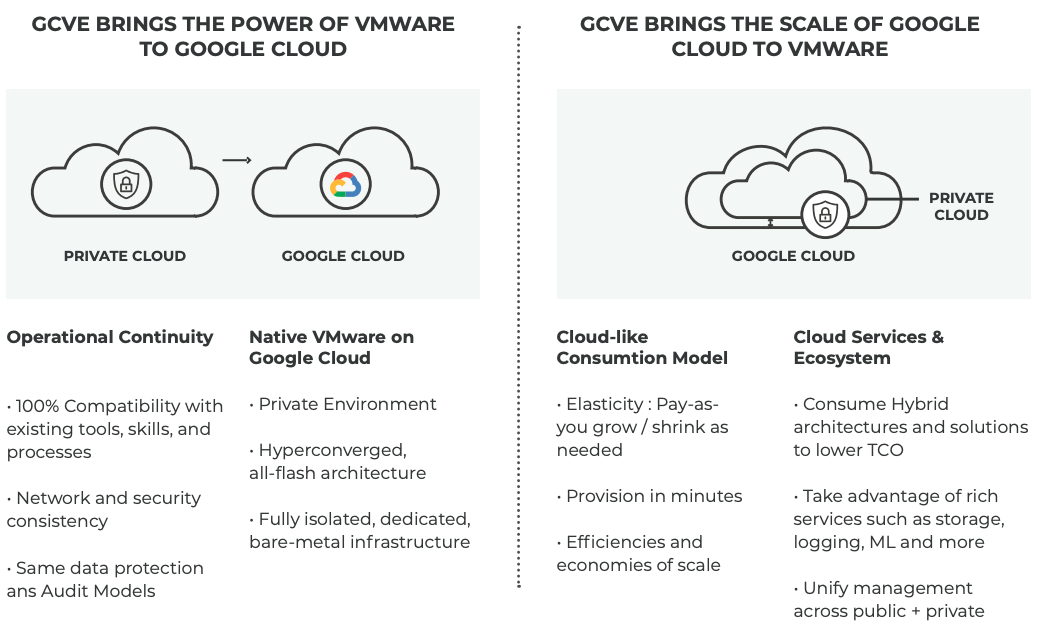
Source: Devoteam G Cloud
Moving workloads to Google Compute Engine (GCE) virtual machines allows for redundancy across multiple zones and thus increases resiliency. The company benefits from the global security of the GCP environment and can rely on auto-scaling to automatically add and remove servers used for support only during peak loads. The company only pays for what it actually needs.
Option 2: Migrate your virtual machines to the Cloud
VM migration, often referred to as Lift & Shift or Rehosting, has often been the preferred method of taking the first steps into the Cloud in recent years. This can be a first step for companies with On-Premises virtual machines who want to transition out of them and into the Cloud. This migration simply consists of moving virtual machines using replication tools. This is done in near-real time, which means that the service can be migrated without interruption. The machines will be managed and supervised while benefiting from the Google Cloud infrastructure, which will increase performance and security.
Re-platform and switch to managed services
The idea is to work from a portfolio of existing applications (legacy) and transform them into containerised microservices intended to evolve, for example on a Kubernetes environment, with a view to improving scalability, or to transpose one’s Big Data environment to the Cloud.
Scenario 1: Transforming your applications into microservices
More and more companies are choosing to modernise their applications to take full advantage of the benefits of the Public Cloud. In practice, this means a thorough review of the application architecture in order to break it down into micro-services that can evolve independently. This facilitates maintenance, simplifies deployment and increases resilience. Today, the use of containers is the solution for deploying these microservices. In production, the orchestration of these containers, i.e. the management of their lifecycle, has become a must. Kubernetes, the open source container orchestration system designed to automate the deployment, scaling and management of IT applications, invented by Google several years ago, has also become a benchmark.
With this solution, Google Cloud simplifies the management of Kubernetes clusters and allows organisations to focus on building new applications for their business rather than focusing on IT infrastructure.
Transforming monolithic applications into microservices

Source: Devoteam G Cloud
Scenario 2: Moving your Big Data environment to the Cloud
Historically, it was the Hadoop framework, invented by Google and made available as open source, that made Big Data a reality. Managing the volume, velocity and variety of data was finally made possible. Behind this, many previously unimaginable business use cases have been created. However, Hadoop remains a complex environment to set up and, above all, to operate. It requires rare and specialised skills despite the appearance of integrated solutions such as Cloudera, Hortonworks, MapR, etc. a few years ago. Thanks to innovative technical solutions, Google Cloud simplifies operations and makes scalability completely transparent. Ephemeral clusters will offer the possibility to pay only for the necessary computing time.
Dataproc’s ephemeral Hadoop clusters take Big Data to the next level
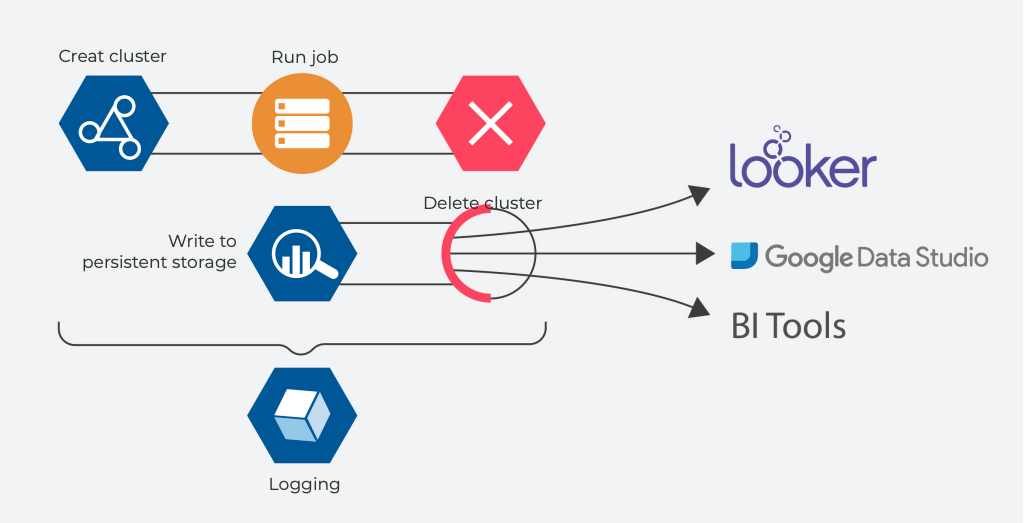
Scenario 3: Opting for Multi Cloud and Hybrid Cloud
For most organisations, there will not be one Cloud but several. More specifically, this translates into a Public Cloud that meets different needs (business, legal, performance, elasticity, availability, flexibility, etc.), a Private Cloud that meets confidentiality issues, and a Sovereign Cloud for compliance or data sensitivity issues.
The ultimate goal is to be completely free of the underlying infrastructure and to focus on your own applications. In this case, Anthos offers a unique solution: based on Kubernetes, the platform allows you to deploy, manage and monitor your applications in a completely transparent way. Regardless of where the applications are run. “At Devoteam, our experience leads us to strongly prefer a Hybrid and Multi Cloud model to a Full Cloud model. Our premise is to focus on security first and then to look beyond technology,” explains Nicolas Sarrazy.
Anthos, the multi-cloud and hybrid cloud platform from Google Cloud
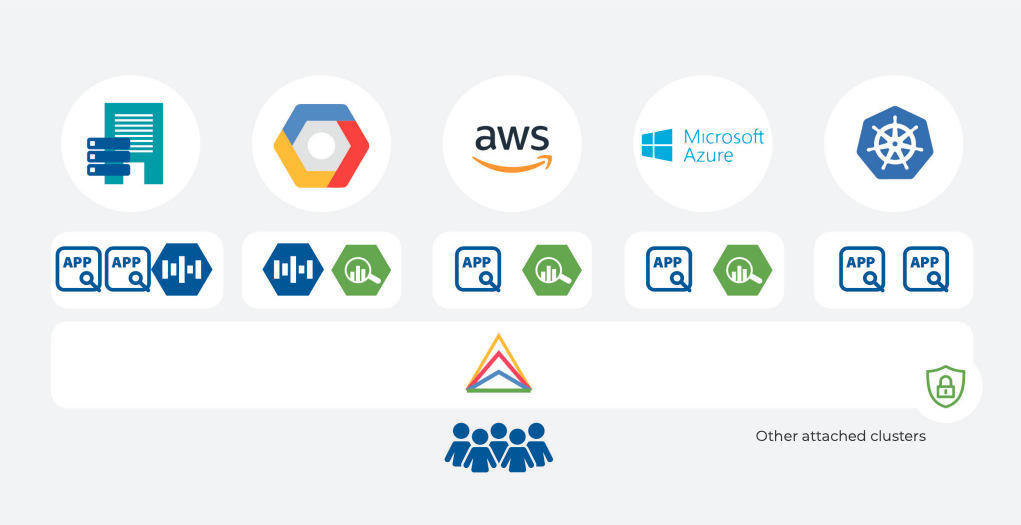
Source: Devoteam G Cloud
Redesign applications or develop new ones with native services
Scenario 1: Developing a full serverless application
Developing applications without worrying about servers, OS or middleware is now possible! Google Cloud allows you to create, develop and deploy functions and applications without worrying about infrastructure. The benefits are numerous: it starts by simplifying the work of developers, which improves their productivity and ultimately reduces the time needed to release new business applications.
Scenario 2: Creating a data environment without ever thinking about the infrastructure.
The majority of organisations continue to have a traditional approach to data warehousing with physical servers or appliances, but the exponential increase in the volume of data generated brings with it technical complexities of scalability, performance, accessibility, etc. but also organisational ones. Teams spend up to 70% of their time maintaining the existing infrastructure rather than seeking new insights in the data.
They are also financial, as the increase in volumes and the obsolescence of the hardware constantly force companies to make costly investments with no guarantee of ROI. Faced with this situation, it is clearly time to modernise the data environment. Google Cloud is a great help in this respect. BigQuery provides a highly scalable, cost-effective, serverless data warehouse designed to maximise business agility.
Example:
The Belgian Randstad Group, which has more than 2,300 employees, turned to Google Cloud and Devoteam to move from a simple mass of information to data that could be put to practical use. A second objective was to find a solution that would allow the data to be analysed in a simple and global way. To move the Group from simple reporting to true in-depth business intelligence, the Devoteam teams created a native Cloud data architecture based on several pillars, including a data lake, a temporary data space, a data warehouse, a data mart and finally, a service interface in an open access environment that allows all employees to consult the data. A software infrastructure was also created to automate a large number of processes.
BigQuery, a unique service for setting up a simple, high-performance and reliable datawarehouse
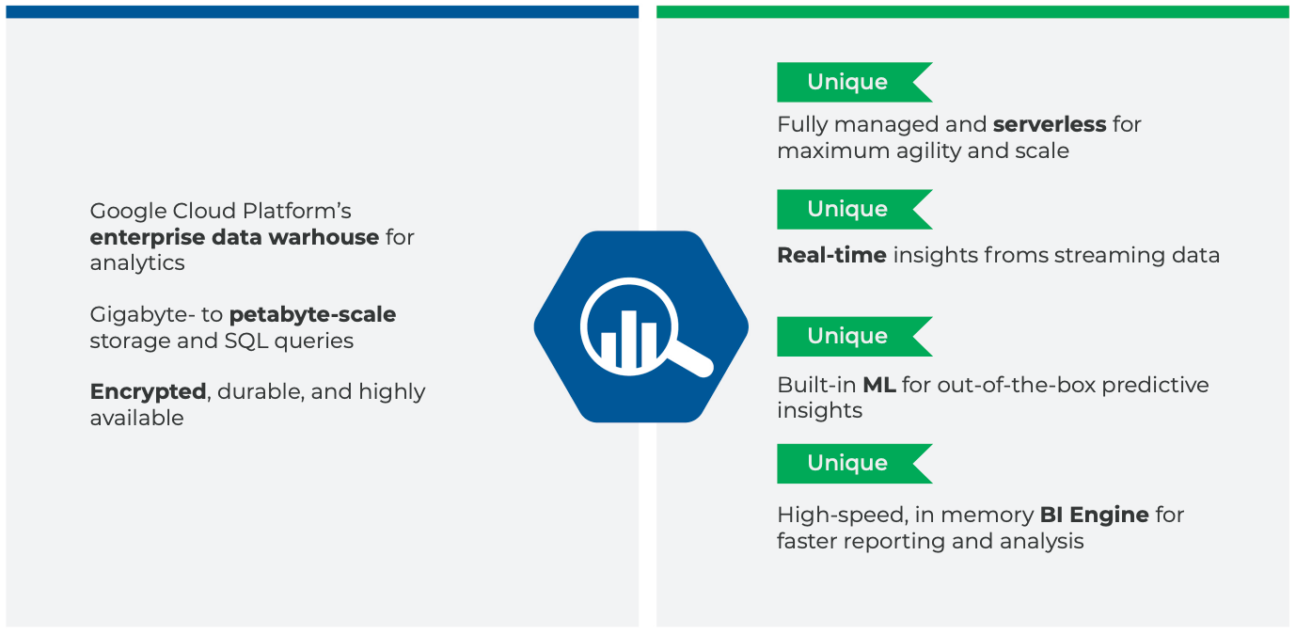
Source: Devoteam G Cloud
Scenario 3: Using the AI provided by Google to innovate in a simple way
Artificial intelligence will enrich experiences, improve processes and automate tedious tasks. The technical capabilities are there and the main obstacle today is the skills required to implement them and the scarcity of their availability on the market. To make artificial intelligence accessible to all, Google Cloud is constantly innovating and provides pre-trained models that can be integrated directly into your applications in the form of APIs. Whether in the field of vision (OCR, image analysis, video analysis, etc.), language (translation, NLP, etc.) or conversational (bot, speech-to-text, text-to-speech, etc.), it is now possible to create applications that benefit from artificial intelligence without needing the best Data Scientists on earth.
Example:
Benoît Couderé is a renowned sommelier who worked for many years as head sommelier in a three-star Michelin restaurant. He is now responsible for the selection of wines for Carrefour Belgium. As there are only a few Carrefour sommeliers who can personally assist customers, it was impossible to cover all of the Group’s 800+ shops. The main challenge was to find a scalable solution that would make it easier to share the expertise of sommelier Benoît Couderé directly with customers in the various shops.
In just three weeks, Devoteam G Cloud supported Carrefour Belgium in the launch of an Alpha version of the virtual assistant “Sommelier Benoît” in three shops. Thanks to this Alpha version, customers were able to engage in a conversation with “Sommelier Benoit”, available on a Google Nest Hub device that they could find in the wine department of their shop. In just 10 days, and without any further marketing efforts, the virtual wine assistant received more than 600 customer interactions in the three Carrefour shops where it was tested.
The virtual “Sommelier Benoît” was able to respond accurately and give relevant wine recommendations in 90% of the interactions. “Without any promotion or marketing, the first interactions were clear: 600 conversations in 10 days and 90% answers provided. Now, thanks to the data, we will be able to improve the virtual “Sommelier Benoît” and allow our customers to access our three-star sommelier, in every kitchen and on every smartphone.” Jean-Philippe-Blerot, Digital & eCommerce Manager.
Workflow of a Machine Learning project

Source: Devoteam G Cloud
